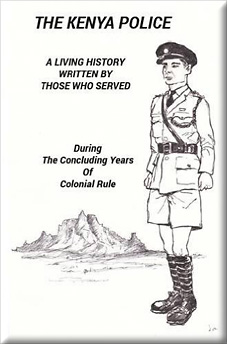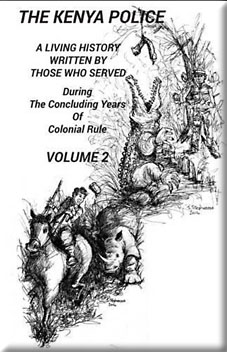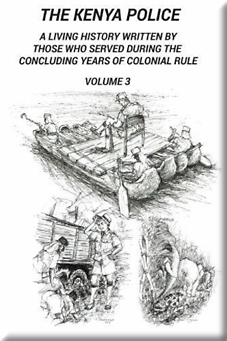|
Review by Peter Fullerton
(HMOCS Kenya 1953-62)
|
|
Volume 1 is a collection of brief memoirs by about 50 former Kenya
Police Officers and a few of their wives. The memoirs are of their
service in the 1950's when they were mostly youngish Inspectors or Chief
Inspectors in charge of district police stations or out-stations. Many of
their postings during the Emergency involved anti-Mau Mau operations,
with some brave incidents recorded; some are memories of hard living in
hot, remote and lonely stations; there are vivid accounts of mounted
safaris in the NFD (on camels and ponies), and some good stories about
murders, mysteries, stock theft, witchcraft, poisoned arrows, rescues on
Mt. Kenya and how to deal with an angry settler. There are amusing
incidents too, such as the British Tommy found in Nairobi walking back to
barracks naked after being stripped by the Madame after a row in a
brothel. There are also jokes at the expense of their senior officers, the
"Aspols" and "Supols" who descended on them for nit-picking
inspections.
A book composed by fifty different writers inevitably means that it is of
uneven quality. The best chapters are about Police operations, especially
those in the NFD against armed tribal raiding parties from Ethiopia in the
course of which several police officers were killed. There are many
tributes to the courage, loyalty and humour of the NCO's and askaris who
served under their command.
John Newton has done his colleagues a service by persuading them to
put pen to paper and provide us with a flavour of what it was like to be a
Kenya Copper, and of the comradeship of those days.
|
|
Volume 2
|
|
The first volume was published in April 2015 and was so well received by
Kenya readers that John Newton decided to invite his former colleagues
to send in a further batch of stories about their service in Kenya. He has
produced another highly readable account of their life and times.
Once again, there is a medley of personal experiences in eighty
contributions ranging from tragedy to comedy. The range illustrates the
variety of duties carried out by Kenya Police Officers in their role of
maintaining law and order in an East African colony developing at an
uneven pace. This meant policing in rapidly growing cities and in 26
Districts varying from densely populated tribal land to vast areas with
nomadic or semi nomadic herdsmen, as well as the "White Highlands" of
European settlers. Thus police duties became specialised in some places
with units such as CID, Special Branch, GSU riot squads, camel-mounted
section (known as Rakhoub), traffic officers and court prosecutors, while
in others the Kenya Police commander in a District covered the whole
spectrum of policing and interface with the public.
The Mau Mau Emergency features high on the list with accounts of horror
and heroism in that long campaign, won by the joint efforts of Kenya
Police and Kenya Police Reserve, British Army, Kenya Regiment, Tribal
Police and Kikuyu Home Guard. Lives were lost and the casualty rate in
the Kenya Police was high amongst both officers and askaris. Patrolling
in the NFD and on the borders with Ethiopia and Somalia was both
arduous and hazardous, where raiding tribes indulged in massacre and stock theft and Somali shifta after independence murdered the first
African DC Isiolo. Other themes are hairy encounters with rhino, buffalo
and elephant; curious tales of witchcraft; narrow escapes from death by
snake bite; grizzly traffic accidents, and mass drownings at Likoni ferry
and on Lake Victoria. The story of the Royal Wajir Yacht Club is told, that
famed watering hole in the NFD. There are homely stories too of wives
and houseboys, including one of an officer who safely delivered the baby
daughter of his cook's wife and met her many years later, now a doctor in
America.
There is much bizarre humour too in this book about offenders, drunks
and eccentrics, and about pranks played on senior officers; and of course
plenty of banter with NCO's and askaris, central to service life and morale.
There is also some non-PC language which many readers will be quietly
pleased to note.
The Kenya Police were one of the largest Colonial Police Forces with well
over 700 European Officers in the 1961 Staff List. Some of the senior
officers had come from other colonial police forces, in particular Palestine
and Malaya; later intakes included many with previous service in UK
Police Forces or the RMP. Recruitment peaked during the Emergency
when many came in from civilian life in the UK or were Kenya-born. All
went through the Kiganjo Police Training School where the standard of
turnout of all ranks under legendary African Sergeant Majors was of a
high order - a feature which was maintained in the service whenever and
wherever on parade. It is pleasing to note in some of the stories in this
book a high regard for several of the senior officers who shaped the
Kenya Police, and for the NCO's who as in all uniformed services were
the key to good discipline.
The Kenya Police Association has for over 50 years kept members in
touch worldwide, especially in Australia where many officers later
migrated. More than a third of those in the service at independence in
1963 are still living. They will enjoy reading this book about the
comradeship of those times, and their families will like it too because it
answers the question: "Daddy, what was it like to be a Copper in Kenya in
those days?"
|
|
Volume 3
|
|
This is the third volume of memoirs of former Kenya Police officers. The
first two volumes both sold over 500 copies and the third volume published
earlier this year is already nearing that figure. John Newton, who compiled and
edited them, has done well to provide us with this unique collection of several
hundred brief Kenya colonial memoirs.
Once again, there is in volume 3 an intriguing variety of personal experiences
of service in the Kenya Police, reflecting the many different kinds of police
postings, from dealing with urban crime in Nairobi to armed incursions into the
NFD from Ethiopia and the Sudan, feuds and stocks thefts amongst nomadic
tribes, as well as more about the arduous campaign to defeat Mau Mau.
The seventy chapters of individual memoirs are mainly by officers who were of
Inspector rank during their service. This is hardly surprising given the fact that
even they are now in their seventies or eighties. Given the passage of time
their memories are remarkably vivid, and the police humour in some of them
comes across as if listening to anecdotes in a club bar. The transition made by
young officers straight from "civvy street" into the rough and tough of their first
postings in Kenya is well described. Footslogging and mounted safaris in the
NFD, patrols rafting down the Tana River, digging vehicles out of deep mud,
hairy encounters with big game, near death from snake bite, handling a violent
psychopathic heavyweight drunk, rescue on Mt. Kenya, the Comet crash and
the tense days of policing in Nairobi just before independence - all these
descriptions as well as competitive sport and club life will bring back memories
of their colonial service to readers. Also included is a fine tribute to Sir Richard
Catling, Commissioner of Police 1954-63.
The fact that Kenya today is one of the more stable countries in Africa is to
some extent due to the colonial years of policing and maintaining the rule of
law; but it is also due to the standards in discipline, training and service set in
those years and passed on to the Kenya Police after independence. There is
one regrettable exception to this claim. In the colonial service corruption in
Kenya Police ranks was virtually unheard of, and it is not even mentioned in
any of the memoirs in this book. Corruption in the Kenya Police today at all
levels is rife, from constables taking petty bribes at road barriers to the failure
to prosecute high level corruption in government. The fine record of the Kenya
Police in colonial times is not remembered in Kenya today, but it is one of
which members of the Kenya Police Association can rightly share the credit.
|
|
|
 |
| Editor
|
|
John Newton
|
| Published
|
|
2015
|
| Pages
|
|
308
|
| Publisher
|
|
Next Century Books
|
| ISBN
|
|
0957583850
|
| Availability
|
|
Abebooks
|

|
 |
| Editor
|
|
John Newton
|
| Published
|
|
2016
|
| Pages
|
|
268
|
| Publisher
|
|
Kenya Police Association
|
| ISBN
|
|
0957583869
|
| Availability
|
|
Abebooks
|

|
 |
| Editor
|
|
John Newton
|
| Published
|
|
2017
|
| Pages
|
|
268
|
| Publisher
|
|
Kenya Police Association
|
| ISBN
|
|
9780957583863
|
| Availability
|
|
Abebooks
|

|
|
